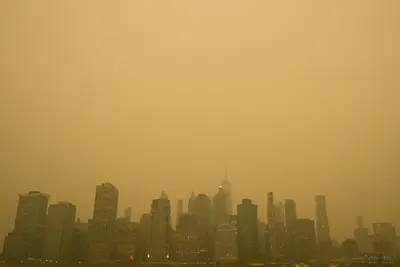Environmental Scientist Uses Sensors to Study Trees’ Cooling Power
 Image by Brooke Coupal
Image by Brooke Coupal
07/28/2023
By Brooke Coupal
A blistering hot day is even hotter in a city.
According to the United States Environmental Protection Agency (EPA), daytime temperatures in urban areas are about 1 to 7 degrees Fahrenheit higher than those in outlying areas. Known as the urban heat island effect, the warmer temperatures are the result of dense concentrations of buildings, roads and other surfaces that absorb and retain heat.
Some cities, including Lowell, are attempting to mitigate heat islands by increasing tree cover. Last year, city officials partnered with UMass Lowell students to collect tree data to aid in the development of an urban forestry master plan.
But how do trees respond to urban environments? And how does the growing threat of climate change affect urban trees? Environmental, Earth and Atmospheric Sciences Asst. Prof. Joy Winbourne is looking for answers.
“There’s a history of assuming cities are concrete jungles, so we’re still learning a lot about how plants behave in cities,” she says. “The field of urban ecology is pretty young.”
Winbourne’s research could help officials select the best tree species for cooling cities.
“Planting the right tree in the right place is really important,” she says.
Tracking Trees’ Water Movement
Along with providing shade, trees can help cool surrounding areas by moving water from the ground into the atmosphere through transpiration. The water is carried through the trees’ stems and released as water vapor, helping to reduce high temperatures by 2 to 9 degrees Fahrenheit, according to the EPA.
To better understand how trees transpire in cities, Winbourne deployed four sap flow sensors on sugar maple trees on UML’s South Campus and a tulip tree near Lowell High School.
 Image by Brooke Coupal
Image by Brooke Coupal
“UMass Lowell being an urban campus allows us to set up studies, both on and off campus, that help us to better understand impacts of urbanization on biogeochemical cycles,” says Winbourne, who plans to deploy sensors on other tree species and in different areas of Lowell in the future.
Using what she calls “the world’s tiniest chainsaw,” Winbourne made slits in the trees to reach sapwood, where water is transported. After allowing time for the trees to undergo a wounding response, she returned to insert the sap flow sensors.
The sensors pump heat into the trees every 15 minutes and then track the movement of that heat. The heat is used as a tracer to measure how fast water is moving within the tree.
Winbourne will also be paying close attention to any extreme weather events that Lowell experiences.
“Climate change is creating more frequent and intense heat waves and precipitation events,” she says. “There are very few field experiments on these extreme events, and how trees respond to heat waves and heavy precipitation could have a really significant impact on the cooling benefits they provide.”
Through the data collected, Winbourne will analyze how prolonged periods of heat and excess stormwater runoff impact water movement in urban trees.
Involving the Community
Helping Winbourne is environmental studies master’s student Evan Paige ’21.
 Image by Brooke Coupal
Image by Brooke Coupal
“I wanted to work on plant-related ecology research,” he says. “It’s a lot of fun getting this hands-on experience.”
Winbourne also teamed up with Tara Goodhue ’09, ’20 to bring the project to Lowell High School, where the latter teaches science. At the end of the school year, Goodhue held her environmental science class outside so students could assist Winbourne with deploying a sap flow sensor.
“This makes science come alive for students, because they’re participating in it instead of just reading about it in a textbook,” says Goodhue, who is also an adjunct professor in UML’s School of Education.
“My big motivator for this partnership is to expose high school students, many of whom might be considering UMass Lowell for college, to the field of ecology,” Winbourne says. “Regardless of the students' path, it shows them that they can be environmental stewards.”
Joeury Garcia, a rising senior at Lowell High School, is interested in environmental science and was excited to learn about Winbourne’s work.
“Helping with this university research really empowers me to help make my community a better place,” she says.


